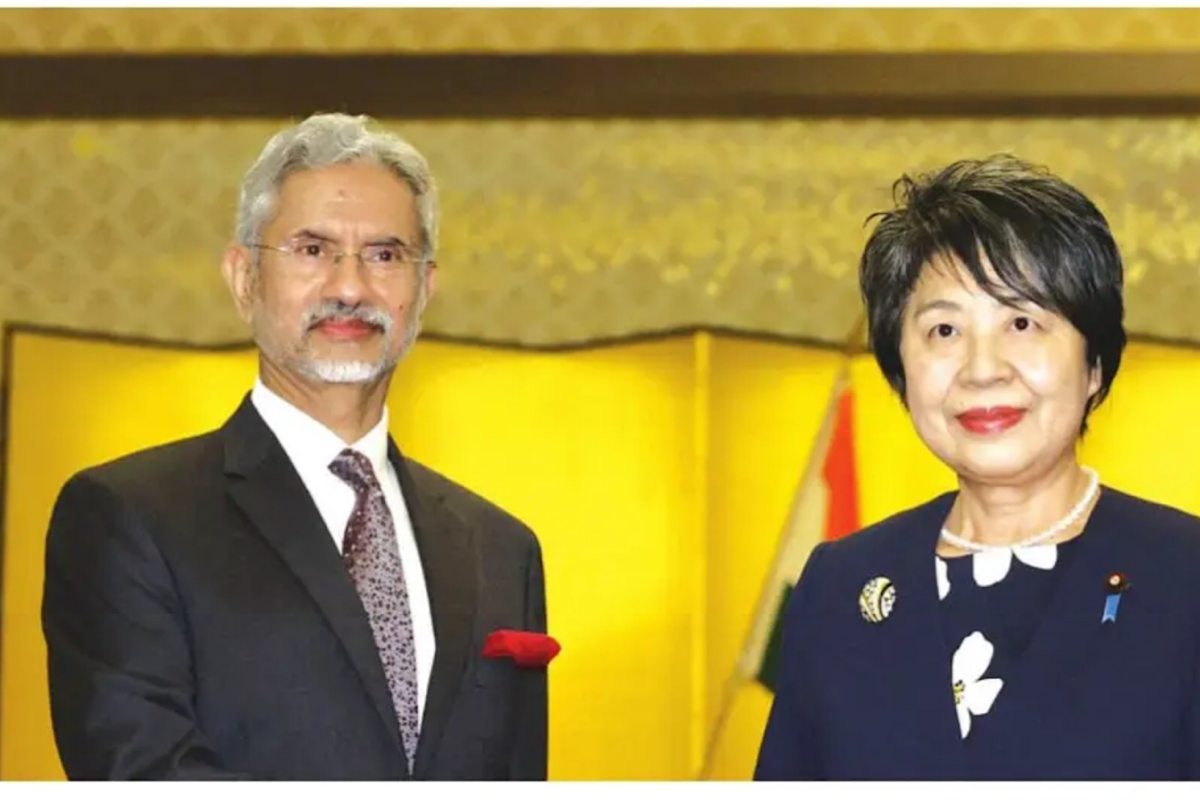During the second leg of his trip to East Asia, External Affairs Minister S Jaishankar explored the scope for stepping up security and economic cooperation with Japan during his twoday stay (March 6-8). Like in South Korea, in Japan too, Jaishankar sought to step up security and economic cooperation and more generally boost ties as the three countries ~ India, Japan, and South Korea ~ respond to China’s growing influence in the Indo-Pacific region.
Jaishankar held a joint news conference in Tokyo along with his Japanese counterpart Kamikawa Yuko wherein both the leaders reaffirmed their countries’ commitment to expand bilateral security cooperation, including in the field of defence equipment and technology transfers. In particular, Kamikawa mentioned the possibility of extending the cooperation between the countries in new areas of space and cybersecurity. Both India and Japan are members of the Quadrilateral Security Dialogue (Quad) grouping that also includes the United States and Australia. It is a framework of cooperation between the four nations on diplomacy, the economy and security.
Through this forum, the four countries have rapidly intensified ties amid shared concerns about China’s increasingly assertive economic and military activities in the region. Indeed, as with South Korea, India and Japan, as two major Indo-Pacific nations share common values, history and interests. Both have an abiding stake in the peace, security, and prosperity in the region, and are ready to play a responsible role commensurate with the needs of the times. Both Jaishankar and Kamikawa noted the rapidly changing strategic relations and a worsening security environment on the global stage where divisions and contention are deepening. Kamikawa expressed keenness in Japan working with India in resolving common issues through dialogue and cooperation.
Putting a premium on her country’s relations with India, Kamikawa appreciated that India by nurturing its own democracy and history, now is well positioned to represent the Global South. In view of the severe security environment in the region, both find it compelling to beef up their defence and security cooperation. For the same reason, both the countries have expanded their joint military exercises. Trade and investment cooperation between the two countries has grown at a rather slow pace and does not reflect the potential.
Japan’s Official Development Assistance (ODA) has played a critical role in India’s economic development process. Both Jaishankar and Kamkikawa expressed their commitment to work together to enhance economic security and supply chain resilience, and deepen cooperation in areas such as semi-conductors, green technology, and digital transformation. Technology collaboration holds great potential as does the mobility of Indian skills and talents to Japan. The Shinkansen project is the current flagship initiative. Japan has been supporting infrastructure development in India.
Japan’s continued help in high-speed rail projects is well appreciated in India. In view of the commonality of interests between the three countries and broad similarities between the scope of that cooperation, the present author had floated the idea of institutionalising a 1.5 Track II dialogue more than a decade ago while he was working with the IDSA. The idea was well-received and two such interactions took place in New Delhi and Tokyo before it went into hibernation.
It is time that the idea is revived and given a push so that new ideas could emerge, which could be useful to policy makers. There is a common complaint in India that Japan’s negotiating style is detailed and long drawn out, which sometimes can be frustrating to the negotiating partner. This feeling is not recent but has remained for years. To appreciate this, cultural understanding between the two sides is very much necessary. Keeping this in mind, ahead of his visit to Tokyo, in an interview with Asahi Shimbun, Jaishankar flagged the issue that Japanese firms are “overly cautious” and have missed India’s untapped potential.
He urged Japanese companies to invest more aggressively in the world’s most populous nation, which is forecast to soon surpass Japan and become the third-largest economy. As of 2022, the number of Japanese companies doing business in India stood at 1,400. In comparison to this, the number of Japanese companies operating in China in 2019 totalled 13,700, though it decreased from around 14,400 in 2012. The number further reduced marginally when Covid-19 broke out in China.
India would expect the number of Japanese companies to increase to 15,000. Global investors and international technology partners are recognizing the rapid transformation that the Modi government has brought in. In a report released in July 2023, the United Nations estimated that India, with its 1.43 billion people, surpassed China as the most populous country. While its nominal gross domestic product is currently the fifth largest in the world, India is projected to overtake Japan and Germany within a few years and trail only the United States and China.
During this transformation, the improved quality of infrastructure and greater ease of doing business brought about by the Modi government is clearly visible. Since global investors and international technology partners are recognizing this, India expects that Japan should not miss the bus by getting entangled with its bureaucratic process of decision-making and miss opportunities. In recognition of the importance of the relationship that India attaches with Japan, New Delhi has given “special emphasis” on promoting Japanese investments with Japan Industrial Townships (11 in number) exclusively for companies from Japan and a fast-track mechanism under India’s Industrial Competitiveness Partnership to support Japanese firms operating in India.
India has set the target of achieving 5 trillion yen ($33.21 billion) investment from Japan by 2027. The only hiccup in the bilateral relations was when Japan responded rather harshly when India detonated a nuclear device in 1998. India felt that Japan failed to appreciate the compelling reason behind India’s decision. This aberration was corrected after then Prime Minister Yoshiro Mori decided to visit India in 2000, opening a new chapter in bilateral relations.
There is however an aberration in the relationship that Japan needs to correct. There are 9 million Indians working in the Gulf region. This huge body of Indian diaspora working there is by itself a strategic partnership involving multiple countries in the Gulf. Compared with this, the number of Indians in Japan is only about 40,000. India would expect Japan to prepare the ground for this number to increase manifold.
RAJARAM PANDA The writer is former Senior Fellow at Pradhanmantri Memorial Museum & Library, New Delhi











